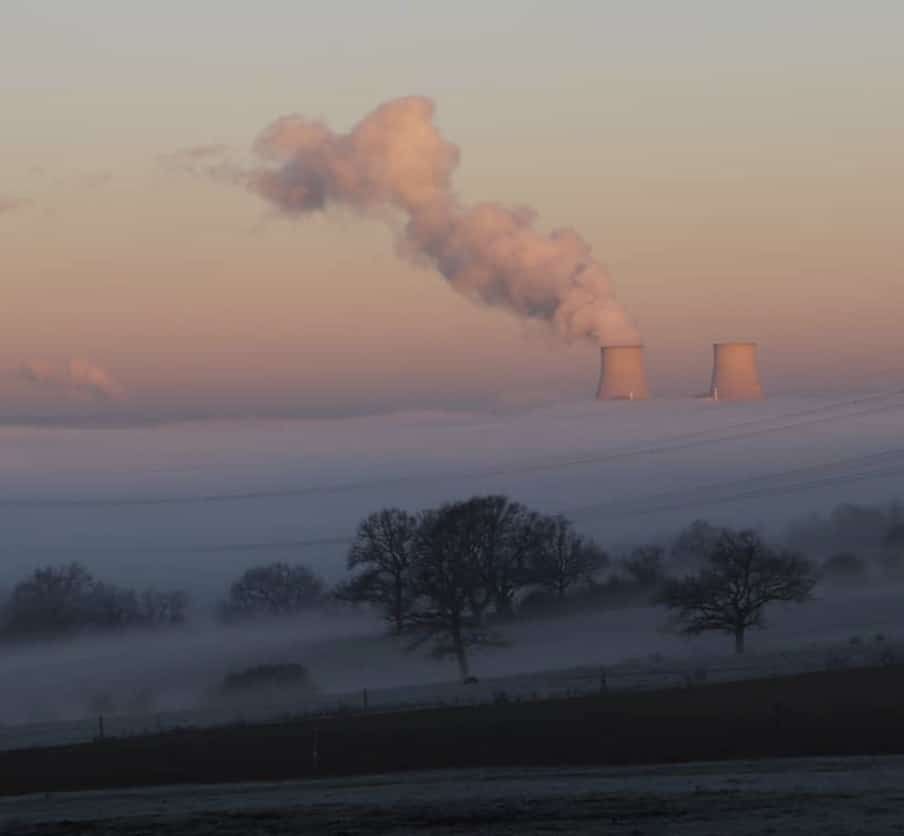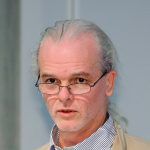The reality of France’s aggressive nuclear power push
By Mycle Schneider | June 3, 2008
 Nuclear power plants at Belleville-sur-Loire, during the haze of winter.
Image courtesy Electricite de France/ Aurélien Ouellette
Nuclear power plants at Belleville-sur-Loire, during the haze of winter.
Image courtesy Electricite de France/ Aurélien Ouellette
“It’s time to look to the French,” New York Times columnist Roger Cohen wrote in January. “They’ve got their heads in the right place, with nuclear power enjoying a 70 percent approval rating.” Similarly, presumptive Republican presidential candidate John McCain has wondered, “If France can produce 80 percent of its electricity with nuclear power, why can’t we?” Even Southern Republicans are becoming Francophiles, with Georgia State Rep. Amos Amerson, chairman of the Georgia House Science and Technology Committee, asking how the French system might help the United States in its “efforts to obtain cleaner, cheaper, more stable energy.”
France is known as the country where nuclear power works. It operates 59 nuclear reactors, which provided 78 percent of its electricity in 2007. Now, the French government has decided to bring the “revival” of nuclear power to the world. The Sarkozy administration has made multiple nuclear cooperation agreements with other nations and the president himself has traveled the world as a nuclear salesman. “The requests by countries that wish to profit from that clean and cheap source of energy are legitimate,” says French Foreign Minister Bernard Kouchner. New bilateral nuclear trade agreements have been negotiated with Algeria, Jordan, Libya, Morocco, Tunisia, and the United Arab Emirates. In addition, France has pledged to assist China, India, and Brazil in expanding their nuclear power programs.
But despite France’s best efforts to the contrary, it’s unlikely that the wannabe nuclear players will implement nuclear power programs any time soon–if ever. None of these countries have the necessary nuclear regulations, regulators, maintenance capacity, or the skilled workforce to run a nuclear plant. The head of France’s Nuclear Safety Authority has estimated that it would take at least 15 years to build the necessary regulatory framework in countries that are starting from scratch. (The French government is well aware of this problem; last month, it created the Agence France Nucléaire International within its Atomic Energy Commission to “help foreign states to prepare the institutional, human, and technical environment necessary for the development of a civil nuclear program.”)
Furthermore, their electricity grids would be unable to handle the increased load from a 1,600-megawatt European pressurized water reactor (EPR) built by the Franco-German joint venture AREVA NP. The increase that a new EPR would represent of total installed generating capacity in a country such as Jordan (1,900 megawatts) or the United Arab Emirates (with roughly 6,600 megawatts, the largest grid of the six Arab candidate countries) illustrates the absurdity of large-scale nuclear deployments in these countries. The grids in such countries would not have the distribution potential nor the capacity to replace nuclear plants that might shutdown or lower output temporarily, wreaking havoc on the countries’ electricity consumers.
The idea of encouraging and promoting nuclear energy seems even more surprising in countries that are beset by armed rebel groups, many of whom have demonstrated stunning levels of unscrupulousness toward their fellow citizens. Some people have labeled civilian nuclear facilities “pre-deployed nuclear weapons.” The phrase becomes particularly significant in this context.
In the meantime, French President Nicolas Sarkozy’s announcement politics perfectly complement the international nuclear industry’s massive campaign to promote nuclear power as a potential answer to climate change. AREVA and its CEO Anne Lauvergeon, whom Cohen dubbed the “stylish ‘Vive les Nukes’ saleswoman,” are offering nuclear plants as if they were pressure cookers at the local market. “We have it in France, why shouldn’t they have it in Morocco?” Sarkozy asked during an October 2007 speech in Marrakesh.
The rhetorical question puts Morocco on the same level as France. In doing so, the French president not only flatters his host but underscores his own authority and strategic view: “If [former French President Charles] de Gaulle had not embarked on nuclear energy, EDF [Électricité de France] would not be today what it is. . . . Tomorrow, I wish that Morocco chooses French civil nuclear energy.” His statement is actually historically incorrect. De Gaulle was instrumental in the launch of the nuclear weapons program, but the large civil nuclear program was launched on March 6, 1974 under President Georges Pompidou and Prime Minister Pierre Messmer. But Sarkozy’s stance is a strong reminder to the international community that France wants to be different–especially from the United States–when it comes to its relationship with the Arab World. So Sarkozy tells Moroccan leaders, “France will be your partner. France makes that political choice. France will accompany you on this road.”
Unfortunately, Sarkozy’s strategy risks contributing to the steady erosion of an international nonproliferation regime “on the brink of collapse.” Moreover, France has a devastatingly poor nonproliferation record, having supplied nuclear assistance to most of the official and unofficial nuclear weapon states around the world. The Israeli bomb program was based on French technology, as was the Iraqi nuclear effort and the South African nuclear program. French companies continue to assist Pakistan and India, which have both used civilian nuclear facilities and materials for military purposes.
The Atomic Energy Organization of Iran still holds 40 percent of the joint French-Iranian consortium Sofidif, which maintains a 25-percent interest in Eurodif, a multinational uranium enrichment group that operates a gaseous diffusion plant in southern France. Currently, the dividends are frozen due to international restrictions over Iran’s contested uranium enrichment program, but tens of millions of Iranian Euros are piling up in French banks as a result of the Shah’s profitable 1974 investment in French uranium enrichment.
French officials are proud of their country’s place as the world’s leading nuclear energy state. Kouchner maintains, “Thirty years ago, France made the choice of nuclear [power]. It was the price [paid for] its independence, its prosperity, its freedom. . . .Today, we have a degree of energy autonomy that profits every French [citizen]. The cost of our electricity is the lowest in the world and our economy is one of the cleanest in terms of carbon emissions.”
Independence, prosperity, freedom–this is strong stuff. And, of course, Kouchner does not forget to point out the price of oil, which “reaches summits and continues to climb.”
But is he correct? For starters, he makes a convenient mistake–mixing up the words “electricity” and “energy.” In 2007, nuclear energy provided 78 percent of France’s electricity, which corresponded to 39 percent of its commercial primary energy but only 18 percent of its final energy. Primary energy is the energy contained in the fuel when it enters the system, while final energy is what is left over for the consumer after processing, transformation, and distribution. In the case of large nuclear or coal-fired power plants, only about one-quarter of the primary energy reaches the consumer’s home, office, or factory. In France, more than 70 percent of final energy is provided by oil, gas, and coal, of which one-half is oil alone, just as in many other countries. This year, the country will face an all-time record energy bill of more than $80 billion.
If the goal was independence from oil, then the target should have been the transportation sector. Already the largest consumer of oil in the early 1970s, oil consumption has increased by 70 percent, far outstripping the oil savings from nuclear energy’s growth in the electricity sector. Today, transportation is responsible for more than one-half of French oil consumption and one-third of the country’s greenhouse gas emissions. With all of the country’s uranium now imported as well–the last French uranium mine closed in May 2001, even though nuclear power is curiously still considered an entirely domestic energy source–it’s difficult to see how the nuclear program could even come close to ensuring the country’s energy independence.
Further claims that French nuclear power costs are “the lowest in the world” can’t be substantiated because nobody knows the cost of the entire domestic nuclear program. For decades, the civilian program has profited from direct and indirect subsidies, in particular through cross-financing with the nuclear weapons program. Current estimates don’t appropriately take into account eventual decommissioning and waste-management costs, which remain a concern and quite uncertain. (In addition to post-fission waste, 46 years of uranium mining has left 50 million tons of waste for eventual cleanup and remediation, the cost of which is unknown.) Official final disposal cost estimates for long-lived high- and intermediate-level fission wastes vary between $21 billion and $90 billion.
Still, fantastic claims about the benefits of French nuclear power persist. In May, the French ambassador to Canada wrote in the National Post, “France is the world’s largest net exporter of electricity due to its very low cost of generation.” Last year, France exported 83 billion kilowatt hours of electricity and imported 27.5 billion kilowatt hours–obviously, a large net export. But the ambassador neglects to mention that France cheaply exports base-load power and imports expensive, essentially fossil fuel-based, peak-load power to use in its citizens’ wasteful winter heating systems. Net power imports from Germany, which is phasing out nuclear power, averaged about 8 billion kilowatt hours over the last few years, and the emissions linked to these imports are attributed to the exporting country, not France. But the radioactive waste stemming from its exported nuclear-generated power–equivalent to the output of a dozen reactors–remains in the country.
Nor do any of the above arguments begin to deal with nuclear safety. In the existing French nuclear fleet, the number of safety-relevant events has increased steadily from 7.1 per reactor per year in 2000 to 10.8 in 2007, even as Électricité de France (EDF) stresses that serious events are declining. This is a disturbing trend considering that the entire fleet is aging and conceivably, such events will only increase with age. There are also the construction errors AREVA has made while building new plants, which are based on the EPR design that the company is hawking worldwide. Last December, the company started an EPR project in Flamanville, France, where French nuclear safety authorities noted that basic technical specifications and procedures such as proper concrete pouring hadn’t been followed, culminating in an unprecedented and unlimited May order to stop cement pouring.
More problems are on the horizon. Some 40 percent of EDF’s operators and maintenance staff will retire by 2015. As a result, France will likely face a formidable shortage of skilled workers. Already, Paris has started fishing in foreign waters for willing students. As the French Embassy in Canada notes on its website: “The need for students in atomic energy is estimated at 1,200 graduated students a year for the next 10 years, although, nowadays, the number of graduated students is 300 per year. . . . Among the most significant initiatives stands the creation of an international master [degree] in 2009 which contents will be taught in English in order to be open to French but also to foreign students.” It’s an odd posture, considering France hopes to sell more nuclear reactors elsewhere in the world, including in Canada. If Paris proves successful at poaching foreign students for its domestic nuclear power program, its potential foreign clients won’t have a nuclear workforce of their own.
Meanwhile, AREVA is struggling to demonstrate that it can build new plants on time and at the estimated cost. For example, after nearly three years of construction, the EPR project in Olkiluoto, Finland, is two years behind schedule and at least $2.3 billion over budget.
So all of this talk about France leading the world toward a renaissance in nuclear power, is exactly that–talk. Besides, nuclear power plays a limited role in the international energy market, providing roughly 2 percent of the final energy available to the consumer–a number that will actually decline in the future as growth rates of nuclear power’s main competitors such as decentralized cogeneration and renewable energy technologies increase. In fact, nuclear building projects will most likely be unable to replace the number of currently operating units that will reach the end of their operational life within the next couple of decades.
Sadly, then, the obsession with nuclear power robs resources from alternative energy strategies that can deliver and have public backing. A recent European Commission study revealed that two-thirds of French citizens polled favor a decrease of nuclear’s share in the power mix, just as the average European Union citizen. Maybe the French do have “their heads in the right place” after all.
Together, we make the world safer.
The Bulletin elevates expert voices above the noise. But as an independent nonprofit organization, our operations depend on the support of readers like you. Help us continue to deliver quality journalism that holds leaders accountable. Your support of our work at any level is important. In return, we promise our coverage will be understandable, influential, vigilant, solution-oriented, and fair-minded. Together we can make a difference.
Keywords: Nuclear Fusion Energy
Topics: Fusion Energy, Nuclear Energy, Opinion














